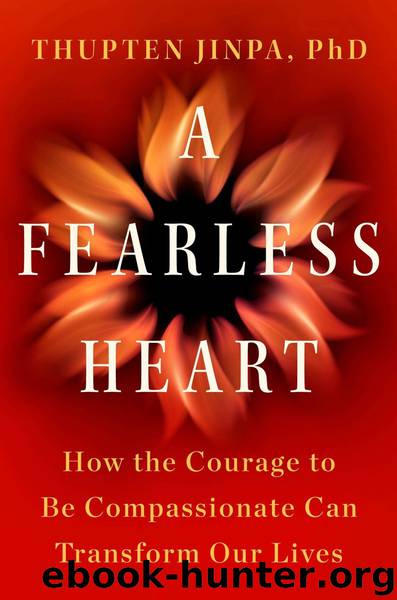A Fearless Heart by Thupten Jinpa

Author:Thupten Jinpa
Language: eng
Format: epub, mobi
Publisher: Penguin Publishing Group
Published: 2015-04-21T04:00:00+00:00
The formal sitting practice we use in our compassion training to help connect with our caring heart, adapted from traditional Buddhist meditation, consists of meditations on loving-kindness and compassion. In Buddhist psychology, loving-kindness and compassion are two expressions of one heart, variations on the essential human theme of caring for one another. Loving-kindness is the wish for someone to be happy, and compassion is the wish for someone to be free from suffering. They’re closely related, but the emphasis is different, with different feeling tones as a result. We can think of them as two sides of the same coin. We can think of compassion as a more specific version of loving-kindness, focused on suffering in particular. They are two of the four immeasurables (Chapter 4), and two ways to approach a person’s well-being.
The root of these practices goes all the way back to the Buddha himself, more than twenty-five hundred years ago. The famed “Metta Sutta” (discourse on loving-kindness) includes an instruction in the form of a series of aspirations for the heart. We incline our heart (and mind—in Pali, the language of the early Buddhist texts, it’s the same word) this way, so that it tends toward wishing happiness for others. The instruction goes:
Wishing: In gladness and in safety,
May all beings be at ease.
Whatever living beings there may be;
Whether they are weak or strong, omitting none,
The great or the mighty, medium, short or small,
The seen and the unseen,
Those living near and far away,
Those born and to-be-born,
May all beings be at ease!
Drawing from this seminal discourse, the Buddhist traditions developed systematic meditation practices for cultivating loving-kindness and compassion for all beings. These traditional Buddhist meditations typically begin with ourselves; that is, our natural aspiration for happiness and our wish to be free from suffering. Then, focusing on a loved one, we wish this person joy, happiness, peace (loving-kindness), and freedom from suffering (compassion). From there, in ever-expanding circles of attention, we wish joy, happiness, and peace for a “neutral” person (someone we don’t have strong feelings about one way or the other), then to a “difficult” person (someone who, we might say, pushes our buttons), and finally moving toward the largest circle—wishing joy, happiness, and peace for all beings.
But, as we discussed in Chapter 2, in the West starting with ourselves tends to bring the process to a screeching halt. So, here, we start with a loved one, and an “easy target” at that. This is someone we get warm fuzzies just thinking about. Our relationship with this person (or animal) is currently uncomplicated enough that bringing him or her to mind evokes predominant feelings of tenderness, affection, and kindness in us. A new parent might choose his infant child. A parent of a six-year-old and a fourteen-year-old who loves both her children equally might reasonably start with the six-year-old if the fourteen-year-old happens to be going through a surly phase. You could choose a beloved grandparent, a close friend, or a cherished pet.
Download
This site does not store any files on its server. We only index and link to content provided by other sites. Please contact the content providers to delete copyright contents if any and email us, we'll remove relevant links or contents immediately.
Inner Engineering: A Yogi's Guide to Joy by Sadhguru(6633)
The Power of Now: A Guide to Spiritual Enlightenment by Eckhart Tolle(5544)
Fear by Osho(4619)
Ikigai by Héctor García & Francesc Miralles(4044)
The Art of Happiness by The Dalai Lama(4009)
The Ultimate Bodybuilding Cookbook by Kendall Lou Schmidt(3854)
Yoga Therapy by Mark Stephens(3668)
The Little Book of Hygge by Meik Wiking(3515)
The Healing Self by Deepak Chopra(3405)
Why Buddhism is True by Robert Wright(3372)
The Hatha Yoga Pradipika (Translated) by Svatmarama(3184)
Being Aware of Being Aware by Rupert Spira(3170)
Shift into Freedom by Loch Kelly(3098)
Wild Words from Wild Women by Stephens Autumn(3041)
Work Clean by Dan Charnas(3006)
Happiness by Matthieu Ricard(2959)
More Language of Letting Go: 366 New Daily Meditations by Melody Beattie(2941)
Yoga Body & Mind Handbook by Jasmine Tarkeshi(2810)
Why I Am Not a Feminist by Jessa Crispin(2666)
